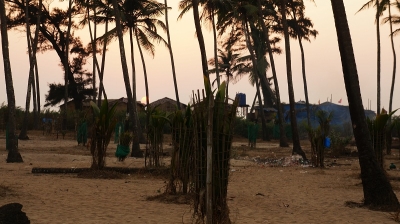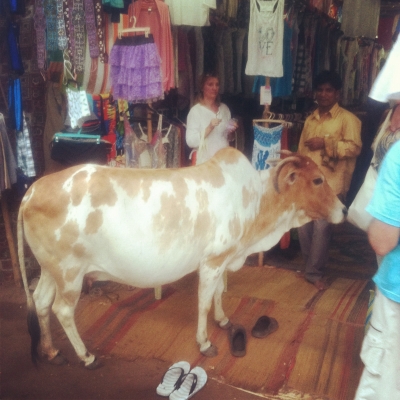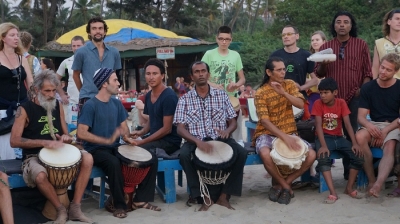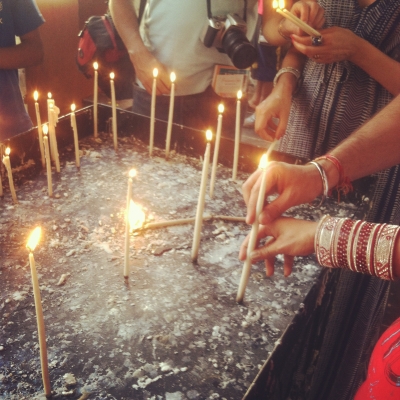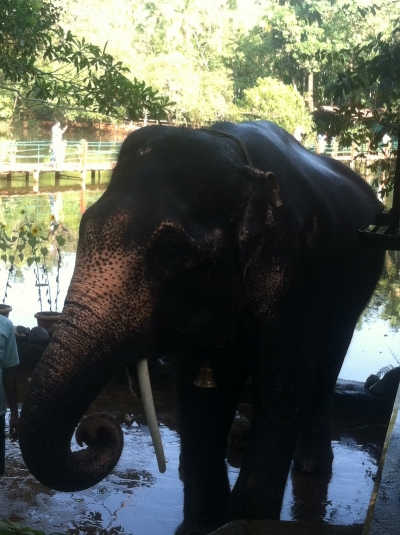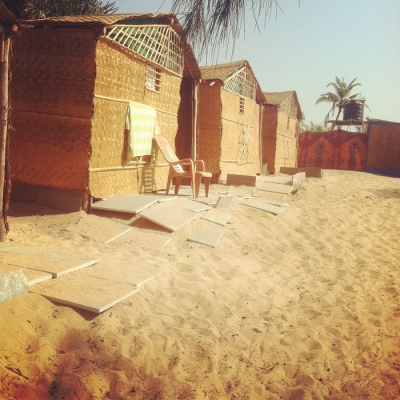
My Marigold Hotel in Goa, India

View of My Street From the Bottom of My Steps
There is a scene in the film The Best Exotic Marigold Hotel where the guests arrive and the look of horror on their faces at the broken & dusty concrete structure they’ve paid to stay at sets the scene for the entire movie. You know from the beginning that they will get through the muck and dust and, once they do, the Marigold Hotel will stand to be the place where magic happens, and their lives are transformed. We know that, as the audience, long before they do.
It wasn’t quite like that when I reached my destination; the villa/apartment I had rented in Arambol, Goa, but it wasn’t too far from it either.
I am spending 3 months in Incredible India! This whole journey came by way of an invitation from a dear friend in England. “Darling, I’ve rented a 2 bedroom place, right smack bang on the beach in Goa. We’d love you to come out. Would you?” was the first thing she said to me when I called. With a quick calculation (3 seconds total) of the pro’s and the cons, I said yes.
Many things changed in the lead up to this trip, with one of the more significant of them being that my friend actually can’t make the journey at all. So, along with one of her friends (whom I’d never met) I had just rented a room in a house in India, sight unseen.
Upon arriving into Goa, by way of Mumbai and Pune, the only directions I had to find this villa was via a text which read “Call this taxi driver, Rajan and tell him to take you to ____ (insert name of English renter) house in Girka Waddo”. No address, no number, no etchings or markings to look for just ‘so and so’s house.’
So, I sent Rajan a text and within a few hours he replied; “Hello lyn may drayvar pick you there with sain of you are name. Can you give me fidbak.” It took me about 24hrs to realize that he wasn’t asking if Drayver (assumed it was the name of his friend) could pick me up, he was telling me that his driver would pick me up with a sign with my name on it. Phonetics 101; when reading a text message from an Indian, read it in their accent.
I precisely gave him fidbak. “Yes, thank you.”
Arriving into Goa
The flight from Mumbai to Goa is a little over an hour and, despite being 45min late (not uncommon) it was an easy, painless flight with Spice Jet for $75 one way.
Flying into Goa, on the right side of the plane, is a view of the Arabian Sea and a lush coastline, punctured with rivers being fed from the sea, which look like veins spreading inland. Once landed, you disembark from the plane onto a bus, which then drives you to the terminal. The terminal is small and tropical looking.
From baggage claim it was an easy walk to the terminal exit. Drayver was there (whose real name I can’t for the life of me remember) with his ‘sain’ which said LYN in big letters that covered the entire page from top to bottom. I liked that he took into consideration that I might have been vision impaired!
Drayver was a stocky little guy, with a gait that said “taxi driver by day, thug by night” and a slicked back hairdo that just said Indian mafia. He drove like he was all three. It’s an hour and a half drive from the airport to Arambol, the north point of Goa. The trip cost 1500 rupees ($30) and the drive was beautiful, harrowing, acrobatic and exhilarating (at different times) as we wound our way through tiny streets, bustling little villages and around hairpin corners on cliff faces – barely breaking speed (no wonder the Indians invented the concept of the aware mind – they can’t be anywhere else when they drive).
There didn’t look to be any signs, at least not to my western eye, and as we closed in on my destination, the roads became dustier, tighter and looked less like roads and more like dirt bike trails. The plume of dust, kicked up from the car stopping suddenly, signaled we had indeed arrived. It was in the pitch black of night.
Rajan, the original taxi driver, met us there whereupon Drayver (who barely spoke English) bid his farewell and left. I climbed the broken concrete stairs to my new abode but no one was about, and I had no key. So, Rajan kindly secured my bags with friends and then escorted me to the beach (only a few hundred feet away, over the dunes) where he left me to have dinner at his friends restaurant in the hopes that my friend might turn up.
Sunjay’s was my first introduction to restaurants in Goa. Sunjay himself, smiling from ear to ear, showed me to the best seat in the house; a padded lounge set right against the ocean.
I ordered a Fish Masala, plain rice, garlic naan and a beer (tuborg). It had been a long day and to end it with a delicious Indian meal to the sound of the waves lapping, while reclining on a bed, felt slightly indulgent, but only for a second. For the remaining 59.99minutes, it felt perfectly appropriate.
I eventually made my way inside my new home; a simple 2 bedroom with bathroom and kitchen, atop another family home. There is a large deck which has a west facing view and spectacular snippets of the sunset; that alone is worth the price. When I say simple I mean very little furniture, besides a mattress that lies on the floor of each bedroom and one in the main area. The floors are all marble, the white washed walls all concrete and the roof is a terracotta tiled shingle style roof. The toilet and shower are all in one room. You can almost sit on the toilet and shower at the same time! This is not uncommon in Indian homes. There is no hot water and an ant would win if it were racing against the pressure of the shower. The kitchen is basic, with a two prong gas burning stove top, a fridge and a few hundred ants. Actually, for an apartment in this area, this is quite a gem.
I fell asleep fairly easily on my first night, eager to explore the area the next day, and dreamt of the magic that might manifest in my new home for the next few weeks; my ‘marigold hotel.
So, what’s it all about? Arambol, Goa
Arambol, Goa is a freedom seekers paradise. It is teeming with flowy, floaty, hippies whose general embrace with each other falls only a few inches short of a good ‘ol feel up and a make-out session. Extended, uncomfortably long silent stares pre-empt most conversation as young freedom seekers ‘hold space’ for each other until someone smiles bigger and then they laugh profoundly at whatever was discussed in the ethos. Without having said a word.
With names like Shanti, Shakti and Vega and dreadlocks and tramp stamps as de-rigueur, you can feel safe knowing that if you forgot your deodorant at home, you’ll fit right in. When ‘long timers’ (the name for westerners who have been coming here each season for many years) find out I’m new to the area they ‘hold space’ with a smile and a vacant gaze and eventually say “Welcome to peace man”, and then walk off.
I’m being entertaining and dramatic of course, there is a really genuine feeling of freedom and creative expression in this area. It is also brimming with interesting, itinerant travelers and it has a strong western influence. However, it’s also where a lot of Indian citizens come to holiday and break free from traditional custom. One morning, as I was sitting on the beach after a swim I saw an older, rotund Indian man cartwheeling his way toward me until he made himself so dizzy he had to stop and walk in circles to re-calibrate. He was only wearing speedos. A bearded, leather skinned, tattooed man played the ukulele, a middle aged Russian man walked by in a thong and a rather buxom blonde emerged from the ocean, naked. This was all before 9am!
At the northern point of the beach, right before the cliff face, there is a high concentration of beach huts and restaurants and it’s where sand meets pavement, this is the main entrance to the busy Arambol shopping area. Here you’ll find a lot more drinking, raucous partying and a long stream of motorcycles lined along the beach. The southern end of Arambol, toward Mandrem, starts to widen and become less crowded.
Set back behind the beach you’ll find that it is quite rural. Cows, pigs and chickens share the dusty, dirt paths with you, which lead out to the main roads. The main roads are paved but barely resemble small country back roads. And, along with little bakeries and convenience stores, small simply constructed fruit stands, whose owners will happily cut you a coconut while you pick out fresh papaya, mango, pomegranate and various vegetables, line the back roads.
Walking Back to My Apartment, the Fequent Spotting of Cows, Sunbathing!
Cows Shop Too
Nothing in Her Size
The main ‘center’ of Arambol is quite a dusty, dirty little crossroads of activity teeming with backpackers and motorbikes. It’s not pretty but it’s where the only ATM in town is, which is often out of money (it’s a 300rupee taxi ride to the next town, which has two ATM machines that may not work either). In my experience, the ATM was always being topped up around 2 or 3pm (note: Maximum 10,000Rps you can withdraw).
There is a lot you can do here in Arambol, Goa but you can easily spend your days having long lunches a few feet away from the sea, enjoy the relatively calm waters or laze around your hotel. I do recommend you take the time to see the sunset, it will make your day complete.
What to do?
The beauty of Goa, is that there isn’t a real need to ‘do’ much. That’s kind of the point. However, there are some great activities to take part in.
In Arambol, you only need to read all the sign postings around town to see what workshop, class or event you want to participate in locally.
If you’re into the healing arts scene, head to Blue Pyramid or Magic Park. Both venues host a plethora of workshops and classes and, in general, you’ll discover a community of people more interested in talking about their chakras, than their hangovers.
Every night there is a drum jam on the beach at sunset. It starts around 5:30pm and goes until about 8pm. Hundreds of people flock to this and you can mingle with International artisans selling their handicrafts.
As for evening partying, most of the parties you will find by word of mouth, there aren’t too many nightclubs. You can ask some of the artisans on the beach, make friends with some of the bartenders, or just follow the music. There are also quite a few bars on the main shopping strip at the north end of Arambol. Coco Loco’s has live music or live DJ’s most nights.
If you’re interested in actually exploring some other parts of Goa, the best way to see everything is to hire a taxi driver for the entire day. For about 1800Rps ($38) the driver will take you to all the ‘must see’ tourist spots. Most taxis have a picture guide in the back pocket of their front seats so you can point to what you want to see.
You will travel through the beautiful town of Mapusa and Old Goa to see the ruins and enter the Catholic Church where St. Augustine’s preserved body is atop an alter in a glass coffin for all to see.
You can go to a traditional Hindu temple where you can spend a few moments with one of the holy men who will happily take you around and explain to you the history and significance, for a small fee.
Ruins of Goa
Cross at St. Augustine's Church in Old Goa
Lighting the Candle at St. Augustines Cathedral
One of the more popular destinations is the spice plantation, where you can take a ride on an elephant and, or, get a shower from an elephant. The spice plantation is a well-oiled operation. For 600Rps you get a 45min guided tour through a small section of the 100acre spice plantation. On the tour, the guide will show you the plant form of well-known spices like cardamom, cinnamon, vanilla and All-spice and will also give you great health uses for the plants. After the tour, it’s a delicious lunch buffet and then (for an additional 400Rps) on to your elephant expedition, if that is what you have chosen. It’s basically Goa’s version of the hop on/hop off bus that you often find in the great cities of London and New York. For a quiet little hippie town, Arambol, Goa is bursting with beautiful things to see and interesting places to be.
The bridge to the Spice Plantation
The elephant just Before it Splashes
Me, Getting Washed by an Elephant
WHERE TO EAT
You won’t have a hard time getting good food here. However, many of the restaurants often have the same menu; traditional southern Indian, western, Israeli, Russian, Italian and Chinese. But there are definitely some gems that stand out.
That said, food is cheap. You can easily have a hearty meal, with a glass of wine or a beer for less than $10. Most restaurants have similar prices so you won’t have to shop for price differences and this is not the place to barter.
It’s not because Sunjay’s was my first introduction to paradise, or that he had me at the big smile when he said Hello. But, long timers will all agree that his food is some of the most delicious. His restaurant is clean, spacious and Sunjay is always present. He also opens his kitchen to his customers who want to learn traditional Indian dishes, like paneer palak (cheese in spinach).
Right next door to Sunjay’s is Sunset. The waiters here are cool and young; all friends and family. I wouldn’t say they are the cheeriest crew, you won’t be greeted with big smiles and warm conversation – (they are young and kinda cool, after all) but I came here most days to use their internet and eat grilled king prawns and eventually, once I became familiar, was greeted with great kindness.
If you’re looking for amazing fresh fish dishes, I recommend Horizon’s, Aladdin’s and Green Garden. They are only a few hundred feet apart from each other but, all with a different feel.
Horizon’s is closer to the action, next door to the banging little dance, live music venue called Coco Loco’s. It’s the largest of the three. A whole grilled fish for two, will cost around 800Rps ($16) or one which will feed 4-6 for 1000rps ($20). They all come with rice and vegetables and chips if you want them. Horizons is the slightly more expensive of the three.
Green Garden has a similar menu and is slightly cheaper. Aladdin’s is the most romantic. Set higher up in the sand dunes than the others, it is easy to feel like you’re tucked away from the crowd below on the beach, but with an expansive view of the sea.
Magic Park was set up over 5 years ago by a Dutch couple and this place has blossomed into something quite magical. It has a rather western style menu but almost all is organic and it is all vegetarian. Think of your regular vegetarian, hippie café back home; mung beans, kombucha, raw chocolate balls, eclectic salads, interesting teas and you have the Magic Park menu. It sits up behind the beach under a canopy of trees. Beautiful, bamboo lounges dot this fabric adorned haven where the temperature is as cool and breezy as its turban crowned patrons. Besides restaurants, check out the fruit stands; fresh cut coconuts for 20Rps, papaya, mango…Goa is a culinary delight.

Magic park
Where to stay
The beauty of Arambol is the transient nature of it. The season is for 6 months; Oct-April, whereupon the Monsoon season settles in for next 6 months. There can be no structures on the beach during the monsoon season and, since most of the restaurants & accommodations (constructed with bamboo, woven straw and fabric; a few ropes holding them all together) line the beach, they get taken down at the beginning of April and then reconstructed again beginning mid-September. So, as you can imagine they feel more native than sturdy but you’ll be quite impressed by the engineering. Rooms are cheap here, even at peak the average price will barely peak at $25 a night. Please take note. There are no addresses given here, you don’t need them. You’ll find everything by name. Also, most don’t have websites; you simply need to call the number provided to book a room ahead of time.
Staying a few hundred feet away from the main action is highly recommended. Remember, the only sound barrier separating you and the outside world is woven straw, so it’s best to stay further south of all the action. If you’re staying on the beach, everything is close enough.
Accommodations along the beach are simple (huts) and, if you’re staying for a 2 week (or less) stay, they are a perfect place to lay your head. Any longer and the novelty of simplicity tends to get a little tiring.
BLUE PYRAMID & DESTINY has 15 huts and is priced from 800-2100Rps (depending on time and availability) Ph.: +91 915 869 6040 (Ask for Pardeep)
This place attracts quite a large yoga, meditation and loved up workshop crowd. It’s actually a great space. Large and open, with a big room in the back where they hold yoga classes and contact jam dances.
SUNJAY (no website) has 19 huts and is priced at 400Rps (all season long) Ph.: +91 992 179 7556
It's by divine intervention I was introduced to Sunjay himself on my first night. All huts have wooden floors, toilet and shower. There is also a little yoga & meditation space, set up on higher ground, which has a gorgeous 360 views of the area. Sunjay has been here for 12 years and knows the area extremely well.
If you’re looking for something a little more comfortable, with modern amenities and a resort feel, I recommend Riva. It’s close to the beach but the entrance is on the main road between Arambol and Mandrem.
Long term apartment rentals are often posted around town and they are quite cheap; from $100 - $300 for the month. Unless you have some contacts in the area, however, it can be a little difficult finding a good deal. It’s best to come here and read some of the postings around town, or ask around.
The magic of Arambol, Goa is the simplicity of it. It’s not a town that boasts a luxury lifestyle. It’s all about freedom and expression, sun and sand here.
SOME TIPS & ADVICE FOR VISITING GOA
Goa is a great starting point if you’re a first timer to India because it gently guides you into some of the quirks of the country. Make no mistake however, that it is one of the wealthiest states in the country so, although you might see poverty and you will have some families approach you for money, it won’t be anything like the slums of some of the bigger cities.
Because of Goa’s many years of high tourism a lot of the feeling of being in ‘India’ is lost and some don’t feel like it is ‘truly’ India. That’s because Goa has a history of attracting people who come here to break tradition and protocol and that’s just what you’ll discover this place is about.
That said, you are still in India. Goa, in general, has turned a blind eye to westerners wearing barely anything but you will be looked upon favorably by the locals if you respect their dress code. Bikini’s on the beach are fine but, while walking around it’s best to cover up a little more.
You will get approached a lot while on the beach, whether you are male or female, by peddlers trying to sell you beads, sarongs and coconuts (they will even offer to clean your ears!) If you are not interested in looking or buying, you must be very firm when you say NO.
The Indian hygiene system is worlds away from the west. Bring a lot of baby wipes, or toilet paper wherever you go. You will often encounter a pretty basic functioning toilet (sometimes only a hole to squat in) and no toilet paper. You will find good toilets in your accommodations however.
You don’t need to pack a lot of clothing for Goa. There isn’t a need for a heavy wardrobe and you will end up buying a lot while you’re there as it’s quite cheap. Remove your shoes whenever you enter any establishment. This is one custom that is observed everywhere.
Bring a flashlight or some lighting device, and charge your devices whenever you can. The power goes out daily and for extended periods of time.
DON’T DRINK THE WATER! Use bottled water for everything, including brushing your teeth. Buy fruit from the fruit stands directly, and washing them with bottled water is advised.
You will find access to the internet everywhere although it might not always be reliable. If you are carrying your own device, Wi-Fi is available at a lot of café’s however, just like the power; it can be a bit spotty. I ended up getting the password to 4 or 5 café’s in a row along the beach so that if one didn’t work, and I was in range of another, the other often did. For 3000Rps and a bit of time you can also purchase a dongle (reliance is the most reliable company) which will give you access on your laptop. Lastly, relax and don’t try to make anything happen. It will happen all on its own here.
As for my apartment, it has truly become like the Marigold hotel where, once I swept away the dust and adjusted to the water temperature, it has become my haven of magic, and dreams coming true. And, isn’t it always the way, don’t we all emerge like lotuses pushing through the dirt and muck eventually?







